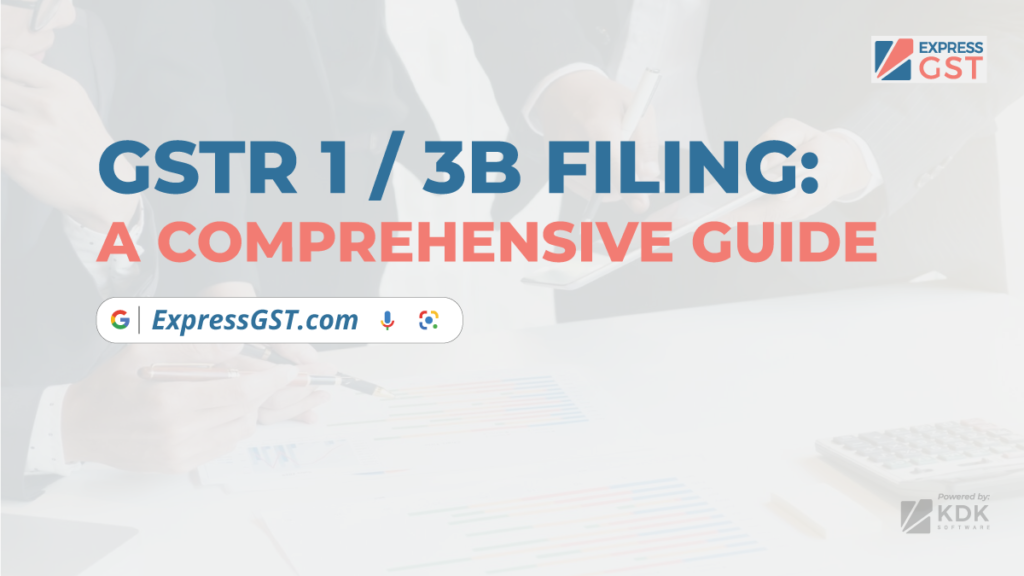GSTR 1 and 3B Filing Simplified: Everything You Need to Know

The Goods and Services Tax (GST) regime has streamlined the taxation system in India, replacing the complex web of indirect taxes with a unified tax structure. One of the key aspects of GST compliance is the filing of GST returns, which includes GSTR-1 and GSTR-3B. In this comprehensive guide, we will explore the intricacies of GST returns, the difference between GSTR-1 and GSTR-3B, the importance of reconciliation, who should file these returns, and how ExpressGST can assist you in filing GSTR-1 and GSTR-3B seamlessly.
What are GST Returns?
GST returns are statements that registered taxpayers are required to file with the tax authorities. These returns contain details of the taxpayer’s income, including sales, purchases, tax collected, and tax paid. They play a crucial role in ensuring compliance with GST laws and are essential for calculating the tax liability of a taxpayer.
What is GSTR-1 and GSTR-3B?
GSTR-1: GSTR-1 is a monthly or quarterly return that contains details of all outward supplies (sales) made by the taxpayer. It includes invoices issued, credit notes, debit notes, and any other relevant documents. GSTR-1 helps in reconciling the data of outward supplies with the data of inward supplies filed by the recipient.
GSTR-3B: GSTR-3B is a summary return that needs to be filed monthly by all regular taxpayers. It contains summarized details of outward supplies, input tax credit (ITC) claimed, and tax paid. GSTR-3B is a self-declaration of the tax liability for the tax period and needs to be filed even if there are no outward supplies during the tax period.
Difference Between GSTR-1 and GSTR-3B
The main difference between GSTR-1 and GSTR-3B lies in their content and frequency of filing. While GSTR-1 contains detailed information about outward supplies and is filed either monthly or quarterly, GSTR-3B is a summary return filed monthly, providing an overview of sales and purchases. GSTR-1 is used for outward supplies reconciliation, whereas GSTR-3B is a self-assessed summary return.
Importance of Reconciliation of GSTR-3B and GSTR-1 Forms
Reconciliation of GSTR-3B and GSTR-1 is crucial to ensure that the data reported in both returns match. Discrepancies could lead to penalties and interest payments. Reconciliation helps in identifying and rectifying such discrepancies, ensuring accurate reporting and compliance with GST laws.
Who Should File GSTR-1 and GSTR-3B?
All registered taxpayers who make outward supplies (sales) are required to file GSTR-1. Regular taxpayers need to file GSTR-3B, irrespective of whether they have made any outward supplies during the tax period. However, small taxpayers with turnover up to Rs. 1.5 crores have the option to file GSTR-1 quarterly, while those with a turnover exceeding Rs. 1.5 crores are required to file it monthly.
How to Revise GSTR-1
In case of any errors or omissions in the original GSTR-1, taxpayers can revise it in the subsequent tax period. However, it is important to note that revisions are allowed only for the previous financial year up to the September return or the annual return, whichever is earlier.
How ExpressGST Helps You File Your GSTR-1 and GSTR-3B
ExpressGST is a cloud-based GST return filing software that simplifies the process of filing GSTR-1 and GSTR-3B. It automates data entry, performs validations to ensure accuracy, and provides real-time updates on the filing status. ExpressGST also offers features for reconciliation, helping businesses identify and resolve discrepancies between GSTR-1 and GSTR-3B.
Conclusion:
Mastering GSTR-1 and GSTR-3B filing is essential for businesses to comply with GST laws in India. These returns play a crucial role in providing transparency in the tax system and ensuring that taxpayers fulfill their tax obligations accurately and promptly.
Filing GSTR-1 and GSTR-3B can be a complex and time-consuming process, especially for businesses with large volumes of transactions. However, with the right tools and support, such as ExpressGST, businesses can simplify this process and ensure compliance with GST laws.
ExpressGST offers a comprehensive solution for businesses to file their GSTR-1 and GSTR-3B returns efficiently. It automates data entry, performs validations to ensure accuracy, and provides real-time updates on the filing status. Additionally, ExpressGST offers features for reconciliation, helping businesses identify and rectify any discrepancies between GSTR-1 and GSTR-3B.
By leveraging the capabilities of ExpressGST, businesses can streamline their GST return filing process, reduce the risk of errors and penalties, and focus on their core operations. With ExpressGST, businesses can stay compliant with GST laws and contribute to the growth and development of the Indian economy.
In conclusion, ExpressGST is not just a software for filing GST returns; it is a partner in ensuring GST compliance and facilitating business growth.
FAQs
Q: Can I file GSTR-1 and GSTR-3B manually?
A: Yes, you can file these returns manually, but it is recommended to use a GST return filing software like ExpressGST for accuracy and efficiency.
Q: What happens if I fail to file GSTR-1 or GSTR-3B on time?
A: Late filing of GST returns attracts penalties and interest. It is advisable to file these returns within the due dates to avoid such penalties.
Q: Is reconciliation mandatory for GSTR-1 and GSTR-3B?
A: While reconciliation is not mandatory, it is highly recommended to ensure accurate reporting and compliance with GST laws.
Q: Can ExpressGST help me with GST compliance other than GSTR-1 and GSTR-3B?
A: Yes, ExpressGST offers a range of features to help businesses with various aspects of GST compliance, including filing other GST returns and managing invoices.

